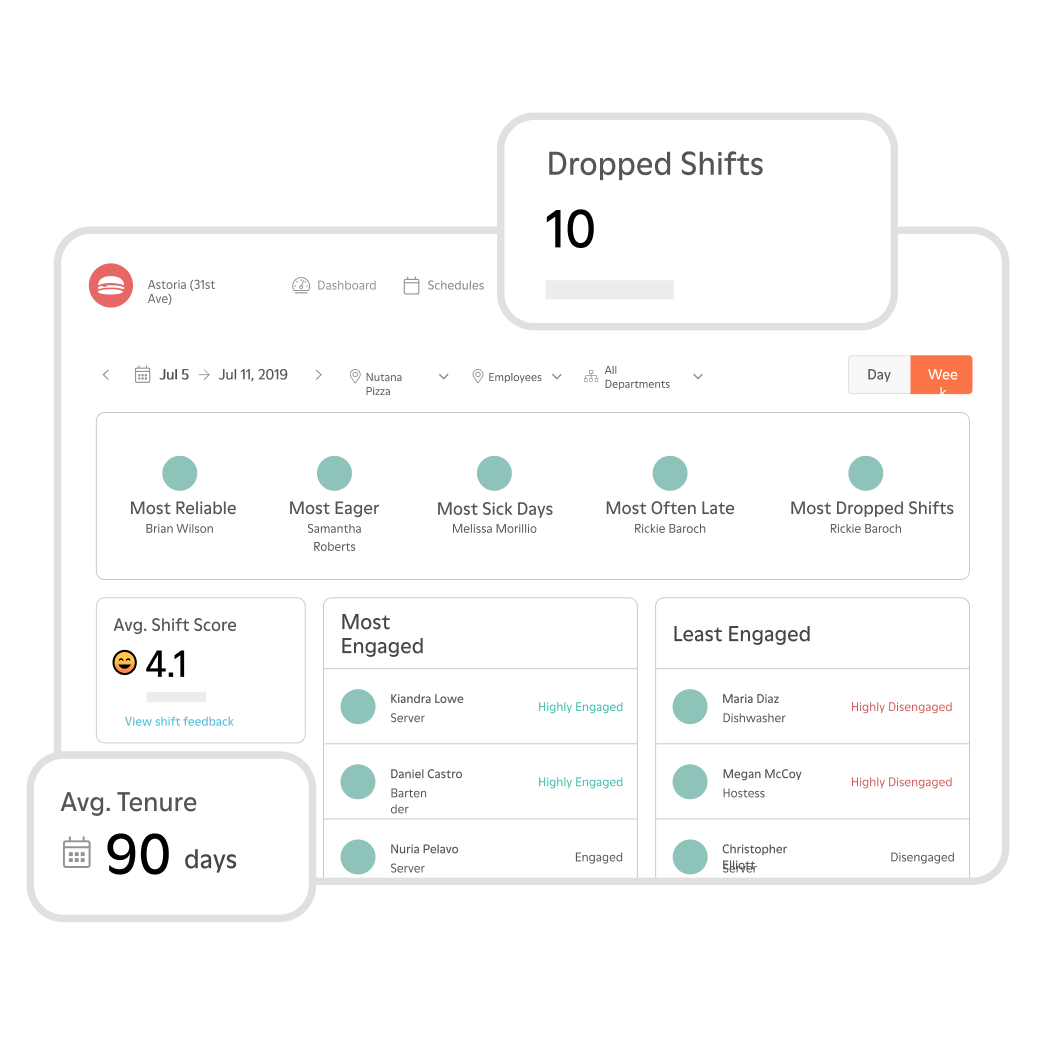It’s no secret that a high staff turnover rate directly inhibits organizational growth. Having strong employee retention means less time and money spent on hiring and training, less knowledge loss, increased productivity, and better customer service. This all translates to more satisfied customers and better business.
So how can you ensure you are creating the right workplace culture to retain employees? We surveyed around 4,000 restaurant employees and found that low pay, lack of recognition, and lack of opportunities for advancement were the top reasons for employees leaving their jobs.
Keep reading to learn how you can leverage 7shifts Engage dashboard to help promote staff engagement, create career development opportunities, and ultimately boost your retention rate.
The Importance of Employee Engagement
Employee engagement is a way to measure how motivated employees are to help your restaurant succeed. An engaged employee is more likely to go the extra mile to ensure tasks are done on time, customers are treated better, and create a positive work environment amongst colleagues. We found that highly engaged employees generate 147% more profits than their less engaged colleagues.
7shifts Engage Dashboard helps identify in real-time, your team’s engagement and satisfaction levels by incorporating data from your schedule, time clock, shift pool, and shift flags. You can see your average employee tenure to keep an eye on retention, and track engagement at each location with statistics showing total lates, sick days, no shows, dropped shifts, and more.

You can also enable Shift Feedback to send automated post-shift surveys to your employees, helping you identify operational issues before they become problems. Feedback is sent to your Manager Log Book, allowing you to monitor trends and search for past feedback.
Increase Employee Recognition
It’s important to be able to identify highly engaged employees so you can easily recognize and reward their behavior to keep them motivated. One study showed that 69% of employees would work harder if their efforts were better recognized.
Once you’re able to easily identify your most engaged employees, how can you better recognize them? We conducted a survey that found:
- 67% of restaurant employees would like to receive paid bonuses as recognition from management
- 38% would like public kudos
- 32% would like promotions
- Nearly 30% would like to receive seniority benefits like time-off priority or better benefits
- 21% want to have an ‘employee of the month’ reward

Motivating Disengaged Employees
Being able to identify your least engaged employees can also provide you with opportunities to create a stronger workplace. Provide additional assistance, training, and coaching to disengaged employees to inspire them to be more invested and engaged in their work.
For example, employees with a lot of dropped shifts, no shows, or lates may need adjustment to their availability. Giving your employees more schedule flexibility shows that you care about their work-life balance, and can reduce stress and burnout.
Disengaged employees can also be a sign that your operations aren’t as efficient as they could be, and additional training may be needed. Ultimately, the Engage Dashboard allows you to be proactive in creating a healthy working environment to help increase employee engagement.
“[The Engage Dashboard] has been really impactful, being able to track on the dashboard, most reliable, most eager, and most often late. It has been good to see our stats on no shows and [dropped shifts] have improved.”
– Sam Aguilar, VP of Operations, Oak and Stone
Career Development
Ensuring your team has advancement opportunities is another key to high employee retention. A LinkedIn study showed that 94% of employees would stay with their employer longer if they invested in their learning and development.
Some ways you can empower your staff’s professional development includes:
- Investing in online courses
- Cross training employees
- Increase job shadowing opportunities
Investing in your employees’ careers will allow them to feel more fulfilled, challenged, gain new experiences, and potentially earn more. This helps employees stay motivated, loyal, and at the end of the day, engaged.
Reading your employees’ Shift Feedback can also help you identify strong employees and provide them with more opportunities to take on new roles and responsibilities.
Uncovering an employee’s potential
Oak and Stone had an employee that didn’t speak English, creating communication challenges and frustration. However, after reviewing his Shift Feedback written with a digital translator, they realized the employee was writing full manager log book notes with potential issues at their restaurant location. The employee showed great managerial potential, having identified valuable habits at closing times that helped fix issues. Being able to identify this employee’s potential allowed management to give him different responsibilities where he could excel. The employee had wanted the opportunity to step up to do more and earn more, and no one would have known if he hadn’t shared it using Engage Shift Feedback.
“That was a big win for us.” –Sam Aguilar, VP of Operations, Oak and Stone
Turnover is inevitable, but you can be proactive to ensure you’re creating the best workplace for your employees and retain top performers. Acknowledging engaged employees, motivating disengaged employees, and recognizing your employees’ potential is just the beginning to a happy, healthy, and productive workplace!
Get started with Engage by signing up for your free 7shifts trial below.

Corina Wan, Sr. Product Marketing Manager
Corina Wan
Sr. Product Marketing Manager
Hi, I'm Corina, Sr. Product Marketing Manager here at 7shifts! I'm excited to share with you all the fun and exciting things happening in the scheduling and team management world.
